The Cable parameter allows you to redefine the length originally specified for any cable in your model. You use Component Name to choose the cable that you want to change.
You click on Define to display the dialog for specifying the cable values, as shown in the figure below. Note that the input here is the total or absolute cable length, not a change in length from the original specification.

Cable Length
The Pipe Section parameter allows you to redefine the length originally specified for any pipe section in your model. You use Component Name to choose the pipe section that you want to change.
You click on Define to display the dialog for specifying the pipe section values, as shown in the figure below. Note that the input here is the total or absolute pipe section length, not a change in length from the original specification.
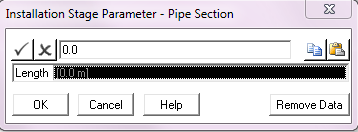
Pipe Section Length
The Vessel Offset parameter allows you to apply an offset to any vessel in your model, or to remove the effect of a previously-applied offset. You use Component Name to choose the vessel that you want to offset. You use Component Name 2 to choose the component representing the actual vessel offset. In this situation, the Component Name 2 drop-down list displays all of the Vessel Offset components in your project file.
You click on Define to display the dialog for specifying the vessel offset values, as shown in the figure below. The option here is to add the offset to this analysis stage, or to remove the offset from this analysis stage. In reality, removing an offset is simply applying the offset in reverse. It is not necessary to have added an offset before you can remove it.
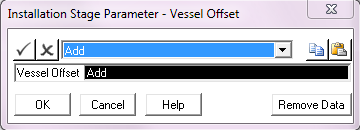
Adding or Removing a Vessel Offset
The Vessel Trim parameter allows you to redefine the trim of the vessel. You use Component Name to choose the vessel that you want to change. You click on Define to display the dialog for specifying the vessel trim value, as shown in the figure below.

Vessel Trim
The Vessel Heel parameter allows you to redefine the heel of the vessel. You use Component Name to choose the vessel that you want to change. You click on Define to display the dialog for specifying the vessel heel value, as shown in the figure below.
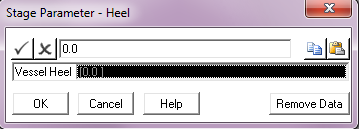
Vessel Heel
The Vessel Surge parameter allows you to apply a vessel surge movement. You use Component Name to choose the vessel that you want to change. You click on Define to display the dialog for specifying the vessel surge value, as shown in the figure below.
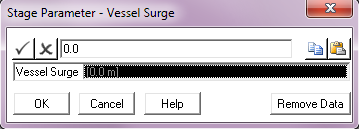
Vessel Surge
The Vessel Sway parameter allows you to apply a vessel sway movement. You use Component Name to choose the vessel that you want to change. You click on Define to display the dialog for specifying the vessel sway value, as shown in the figure below.
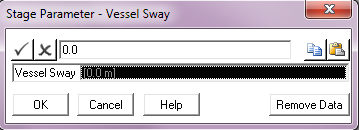
Vessel Sway
The Vessel Yaw parameter allows you to apply a vessel yaw movement. You use Component Name to choose the vessel that you want to change. You click on Define to display the dialog for specifying the vessel yaw value, as shown in the figure below.
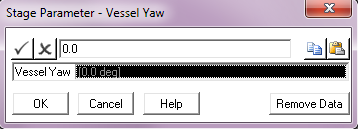
Vessel Yaw
The Heave Offset parameter allows you to apply a heave offset to any vessel in your model. You use Component Name to choose the vessel that you want to change. You click on Define to display the dialog for specifying the heave offset value, as shown in the figure below.
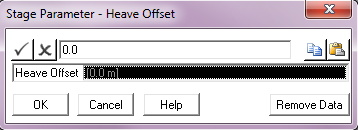
Heave Offset
The Intersection Point parameter allows you to move connection points from their position as originally specified on a Line component. You use Component Name to choose the point you want to move. You are presented with a list of all of the connections defined on Line components included in your model.
You click on Define to display the dialog for specifying intersection point values, as shown in the figure below. The input here is the new position of the connection measured from the start of the line, not a change in length from the original specification.

Intersection Point Position
The Water Depth parameter allows you to redefine the water depth that was originally specified in your Model component.
You click on Define to display the dialog for specifying the water depth values, as shown in the figure below. Note that the input here is the total or absolute water depth, not a change in length from the original specification.
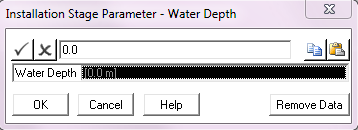
Water Depth Specification
Note
All vessel data is referenced as relative to the mean water line. Therefore, it is not necessary to redefine vessel data when you change the water depth.
The Load parameter allows you to apply a load at any connection point in your model, or to remove the effect of a previously-applied load. You use Component Name to choose the connection point at which to apply the load. Note that connection in this case includes fixed and vessel connection points defined in your Model component, as well as all connection points defined in Line components. You use Component Name 2 to choose the actual load or moment. In this situation, the Component Name 2 drop-down list displays a list of all of the Load components in your project file.
You click on Define to display the dialog for specifying the load values, as shown in the figure below. You can add or remove a load from this analysis stage. If you add a load, it replaces any loads previously specified for that connection point. The loads do not combine together. Removing a load leaves the connection point without any load specified on it. When you remove a load, you must specify the last load applied at that connection point or the program will issue a warning.
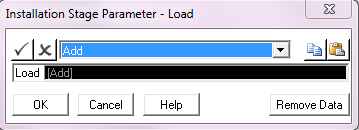
Adding or Removing a Load
The Constraint parameter allows you to remove any fixed constraint defined on your Model component, or to reapply a previously-removed constraint. You use Component Name to choose the constraint you want to define. In this situation, the Component Name drop-down list displays a list of all of the Fixed Connection Points in your Model component.
You click on Define to display the dialog for specifying constraint values, as shown in the figure below. The options here are Off to remove the constraint, or On to reapply a constraint removed in an earlier stage. The default is Off. Obviously if no constraint was previously removed, On has no effect.

Adding or Removing a Constraint
The Stinger parameter allows you to redefine the hitch rotation (for an S-lay stinger) or the tower angle (for a J-lay tower) for a Stinger that is specified on the Vessel component of interest. You use the Component Name drop-down to choose the vessel of interest.
You click on Define to display the dialog for specifying the stinger values, as shown in the figure below. Note that the input here is the total or absolute angle or rotation, not a change in angle from the original specification.
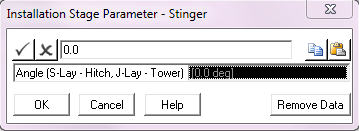
Stinger Angle Specification
The Stinger Radius of Curvature parameter allows you to redefine the Stinger Radius of Curvature (for an S-Lay Stinger with a Radius of Curvature configuration) for a Stinger that is specified on the Vessel component of interest. You use the Component Name drop-down to choose the vessel of interest.
You click on Define to display the dialog for specifying the stinger values, as shown in the figure below. Note that the input here replaces the values defined on the Stinger and, if left blank, uses the values defined on the Stinger.

Stinger Radius of Curvature Specification
The Vessel Radius parameter allows you to redefine individual entries on the Vessel Radii of Curvature that is specified on the Vessel component of interest. You use the Component Name drop-down to choose the vessel of interest.
You click on Define to display the dialog for specifiy the vessel values, as shown in the figure below. The Radius Entry No. specifies which entry in the Radii of Curvature dialog to replace. Note that the input here replaces the values defined on the Vessel and, if left blank, uses the values defined on the Vessel.

Vessel Radii Specification
The Support parameter allows you to remove a rollerbox support defined in a Vessel component in your Model component, or to reintroduce a previously-removed support. You use Component Name to choose the support you want to define. In this situation, the Component Name drop-down list displays a list of all of the rollerbox supports on all of the vessels in your Model component.
You click on Define to display the dialog for specifying support values, as shown in the figure below. The options here are Off to remove the support, or On to reintroduce a support removed in an earlier stage. The default is Off. Obviously if the support was not previously removed, On has no effect.
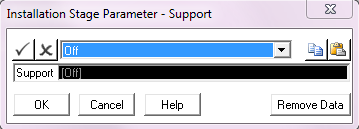
Adding or Removing a Support
The Cable Start and Cable End parameters allow you to redefine how the start and end of a cable is connected to the model. You can use these parameters to connect and disconnect cables during an analysis. You use Component Name to choose the cable component that you want to change. You use Component Name 2 to choose the connection point at which the start or end of the cable is connected to the model. To allow the start or end of the cable to hang freely from the model, select <none>.
The Line Start and Line End parameters allow you to redefine how the start and end of a line is connected to the model. You can use these parameters to connect and disconnect lines during an analysis. You use Component Name to choose the line component that you want to change. You use Component Name 2 to choose the connection point at which the start or end of the line is connected to the model. To allow the start or end of the line to hang freely from the model, select <none>.
Note
This parameter is provided for users who are performing specialist lay operations such as the analysis of pipeline self-installation from an FPU.
The Friction Modelling parameter allows you to redefine the friction properties of the seabed. The Seabed component specifies a longitudinal and transverse friction coefficient along with a kinetic friction factor.
When you select this parameter type, the Component Name and Component Name 2 drop-down lists are disabled. You click on Define to display the dialog for specifying the friction modelling values. The dialog varies depending on whether or not the installation stage is a restart as follows:
▪If the installation stage is a restart, the dialog shown in the figure below is displayed. You can define the Static Longitudinal Coefficient, Static Transverse Coefficient, and Kinetic Friction Ratio.
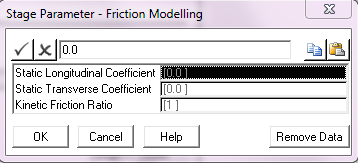
Static Friction Modelling
▪If the installation stage is not a restart, the dialog shown in the figure below is displayed. In addition to the properties displayed for a restart, you can also define the Assume Longitudinal Friction Distribution and Direction properties.
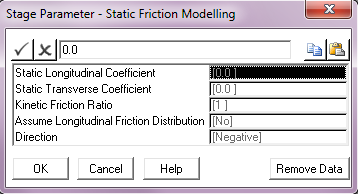
Friction Modelling
The Assume Longitudinal Friction Distribution option that is available in the Stage Parameter – Static Friction Modelling dialog enables you to apply a force equal to the limiting friction force along the seabed. The limiting friction force is the weight of pipeline along the seabed multiplied by the Static Longitudinal Coefficient. This force replicates the actual limiting force applied when the limiting friction is exceeded by the movement of a vessel and therefore, the limiting force applied when the pipeline begins to move. The Assume Longitudinal Friction Distribution option is intended to give you the choice of creating a model with a significant amount of pipeline already laid on the seabed. The assumed friction force is then applied to the pipeline on the seabed to reproduce the friction force applied by the movement of a vessel. The friction force along the pipeline on the seabed is equivalent to a model where a vessel is moved a requisite distance to induce pipeline movement. To reproduce the movement of the vessel accurately, the direction of vessel motion must also be known so that the limiting friction force can oppose the motion. The Direction option enables you to specify the direction of the friction force. If you specify Positive, the direction of the limiting friction force is applied in the positive y-axis. If you specify Negative, the direction of the limiting friction force is applied along the negative y-axis.
The Cable Stabiliser allows you to apply initial stabilising boundary conditions to any cable in the model. You use the Component Name drop-down list to select the cable you wish to stabilise. Click on Define to display the Stabiliser On/Off drop-down option.
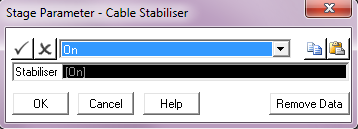
Cable Stabiliser
When stabilisation is switched On for a particular component its start and end points are pinned for the initial static analysis step and are then released during a subsequent quasi-static step, after which the normal static analysis procedure takes place. This two-step process is intended to allow models to reach a fully equilibrium state before trying to perform a full static analysis sequence on them.
Such stabilisation is useful for scenarios where there are natural hinge points along the pipeline, for example where cables meet heavy rigid bodies, and these points tend to move suddenly during the initial static step leading to instability and convergence difficulties. Certain start-up or laydown procedures are examples of such scenarios.
The option for component stabilisation represents a time saving alternative to just manually adjusting the suspended line length in order to achieve convergence for unstable models. Note that stabilisation is not required for typically robust model types, such as normal lay.
The Pipe Section Stabiliser works in the same manner as the Cable Stabiliser above and allows you to apply initial stabilising boundary conditions to any pipe section or multiple pipe sections in the model. You use the Component Name dropdown list to select the pipe section you wish to stabilise. Click on Define to display the Stabiliser On/Off drop-down option.
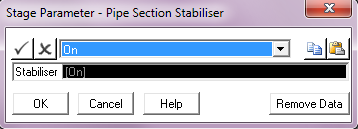
Pipe Section Stabiliser
See Cable Stabiliser above for details of the stabilisation operation when set to On for a component.
Note
This parameter is provided for users who are performing specialist lay operations such as the analysis of pipeline self-installation from an FPU.
The Pay Out (Pipe) parameter type enables you to add a length of pipeline to the model. However, there are restrictions to using this parameter type, as follows:
▪This parameter type is only available for restart installation stages.
▪You can only add a length of pipeline to the model if the Line component in the model was specified using the Payout option instead of the Standard option.
▪You can only have one Line component specified using the Payout option in each model.
When you select this parameter type, the Component Name and Component Name 2 drop-down lists are disabled. You click on Define to display the dialog for specifying the pay out pipe values. The dialog that is displayed varies depending on whether or not the installation stage is a static or dynamic stage type as follows:
▪If the installation stage is static, the dialog shown in the figure below is displayed. You can specify the Length of the pipeline that you want to add to the model.
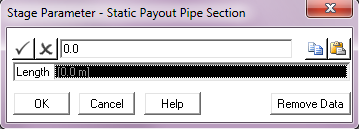
Static Payout Pipe Section
▪If the installation stage is dynamic, the dialog shown in the figure below is displayed. You can specify the Length of the pipeline that you want to add to the model and you can also specify the Rate at which the pipeline is added to the model.
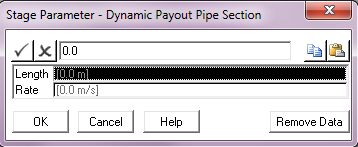
Dynamic Payout Pipe Section
Note
This parameter is provided for users who are performing specialist lay operations such as the analysis of pipeline self-installation from an FPU.
The Pay Out (Cable) parameter type enables you to increase the length of a cable section in the model. This parameter type is only available for restart installation stages.
PipeLay implements this function in a different way to the Pay Out (Pipe) section in that the Pay Out (Pipe) option increases the length of the pipeline by adding additional inactive pipe elements to the model, whereas the Pay Out (Cable) option increases the length of the cable by increasing the length of the existing cable elements.
When you select the Pay Out (Cable) option, the Component Name drop-down list displays a list of all of the Cable components in the model. Select the cable component that you want to increase. You cannot use the Pay Out (Cable) option to increase cable components that come in contact with the seabed.
You click on Define to display the dialog for specifying the pay out cable values. The dialog varies depending on whether or not the installation stage is a static or dynamic stage type as follows:
▪If the installation stage is static, the dialog shown in the figure below is displayed. You can specify the Length of additional cable that you want to add to the model. The cable is added to the model uniformly at each static stage.
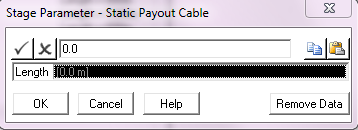
Static Payout Cable
▪If the installation stage is dynamic, the dialog shown in the figure below is displayed. You can specify the Length of additional cable that you want to add to the model, the Winching Velocity, Ramp-up Start, Ramp-up End, Ramp-down Start, and Ramp-down End.

Dynamic Payout Cable
Note
This parameter is provided for users who are performing specialist lay operations such as the analysis of pipeline self-installation from an FPU.
The Pay In parameter type enables you to reduce the length of a pipeline or cable section in the model.
When you select the Pay In option, the Component Name drop-down list displays a list of all of the pipe and cable components in the model. Select the component that you want to reduce. You click on Define to display the dialog for specifying the pay in values. The dialog varies depending on whether or not the installation stage is a static or dynamic stage type as follows:
▪If the installation stage is static, the dialog shown in the figure below is displayed. You can specify the Length of pipeline or cable section that you want to remove from the model. The length of cable or pipe is removed uniformly from the model at each static increment.
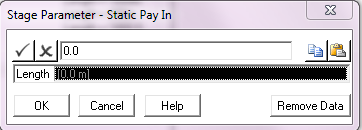
Static Pay In
▪If the installation stage is dynamic, the dialog shown in the figure below is displayed. You can specify the Length of pipeline or cable section that you want to remove from the model, the Winching Velocity, Ramp-up Start, Ramp-up End, Ramp-down Start, and Ramp-down End.
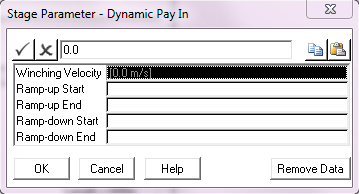
Dynamic Pay In
Note
This parameter is provided for users who are performing specialist lay operations such as the analysis of pipeline self-installation from an FPU.
The Friction Sensitivity parameter type enables you to perform a series of sensitivity analyses using varying static longitudinal friction coefficients in conjunction with a specified vessel offset. This parameter type is only available for restart installation stages.
In the Friction Sensitivity analysis, PipeLay compares the seabed pipeline movement calculated in each sensitivity analysis to a seabed pipeline displacement that you specify. PipeLay uses interpolation to calculate an exact static longitudinal friction coefficient corresponding to the pipeline displacement that you specified. The analysis report file that PipeLay generates displays the friction coefficient along with a table of pipeline movement for each sensitivity analysis. You can then use the friction coefficient in subsequent analyses to give an exact representation of the static longitudinal friction coefficient.
When you select the Friction Sensitivity option, the Component Name drop-down list displays a list of the Vessel components in the model. In the Component Name drop-down list, select the vessel component that you want to analyse. The Component Name 2 drop-down list displays a list of the Vessel Offset components. In the Component Name 2 drop-down list, select the vessel offset that you want to use.
You click on Define to display the dialog for specifying the friction sensitivity values, as shown in the figure below.
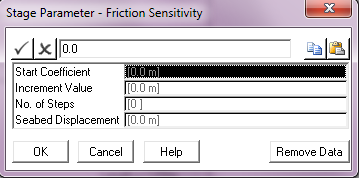
Friction Sensitivity
The Active Length Change parameter type enables you to change the length of an active region on a line component in the model. This parameter type is only applicable to static restart installation stages.
When you select the Active Length Change option, the Component Name drop-down list displays a list of all of the Line components in the model. Select the line component that you want to change. Note that you should only select a line component that has an Active Length type specified.
You then click on Define to display the dialog for specifying the length change, as shown in the figure below. Note that the Change input here is the amount by which you want the analysis to change the length of the active region on the line component during the corresponding static restart stage. The procedure for applying such a change is outlined in the 'Line Component Type' section of the Line component.
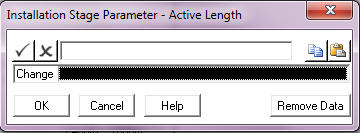
Active Length
The Wave Height parameter enables you to alter the primary wave height in a particular installation stage. This ability can be used to perform sensitivity analyses using varying values of wave height. This parameter is only available to dynamic installation stages, both in restart and non-restart analyses.
When you select the Wave Height parameter option, click on Define to display the dialog that allows you to specify the new value of wave height as shown in the figure below.
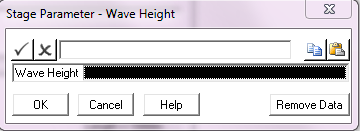
Wave Height
The Wave Period parameter allows you to alter the period of a primary wave in an installation stage. This ability can be used to perform sensitivity analyses using values of wave period that change with each new installation stage. This parameter is only available to dynamic installation stages, both in restart and non-restart analyses.
When you select the Wave Period parameter option, click on Define to display the dialog that allows you to input the new value of wave period as shown in the figure below.
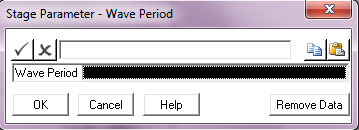
Wave Period
The Wave Direction parameter enables you to alter the direction of a primary wave in an installation stage. This ability can be used to perform sensitivity analyses using values of wave direction that change with each new installation stage. This parameter is only available to dynamic installation stages, both in restart and non-restart analyses.
When you select the Wave Direction parameter option, click on Define to display the dialog that allows you to specify a wave direction as shown in the figure below.
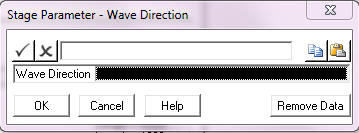
Wave Direction